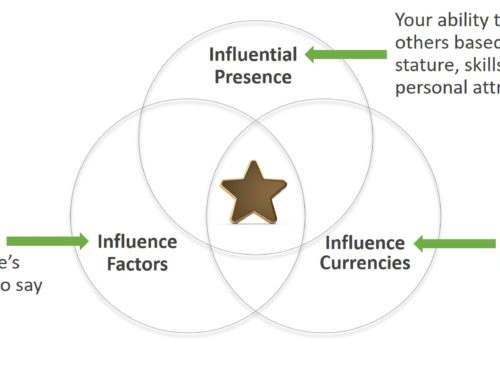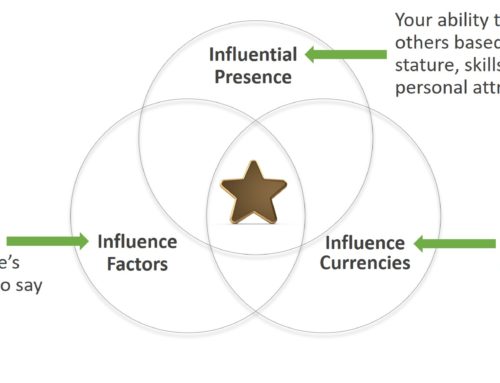My last blog described the first four action/reaction influence techniques that IT professionals can use when trying to influence their business partners or others with the IT organization. This week’s blog discusses the remaining five techniques.
5. Doing Tasks You Don’t Like
As a IT manager or executive, if you do all the fun stuff and leave the important but uninteresting or dangerous tasks to others, many issues will arise, including:
- Your team will resent you.
- Your staff will be unwilling to perform unwanted tasks.
- Your team’s motivation will be reduced, resulting in lower productivity and increased attrition.
Your action of sharing the uninteresting or dangerous tasks has the reaction of:
- Showing people you are a team player, thus, increasing their willingness to follow your instruction.
- Causing your team (and others) to perform these tasks more willingly because they know you won’t ask them to do anything you wouldn’t do yourself.
6. Taking Logistical Control
Taking logistical control is a negotiation trick that employs both influence and team-building-based concepts. From an influence perspective, being proactive and organizing the group’s logistical needs positions you to take a leadership role in the overall negotiation process. From a team-building perspective, once you have taken a leadership role and the group’s culture is formed, modifying that culture becomes very difficult, thus cementing your role as the overall negotiation leader.
Continuing with the negotiation example, if you take care of the negotiation’s logistics, such as booking the conference room, sending out the meeting invitations, and ordering lunch, the group will be more likely to follow your direction regarding negotiation-related items.
Moving to an IT Help Desk example, if the Help Desk technician provides the full complement of skills and logistics needed to deal with a user’s technical issues, it not only increases user satisfaction, it also increases the reputation of the technician and raises the respect for IT in general.
7. Paying Vendors Quickly
Prompt payment helps you maximize attention, support, and influence over your vendors. Paying your vendors quickly (even immediately, if possible) is especially effective with smaller vendors who are very attuned to their cash flow and accounts receivable. In short, the faster you pay them, the more likely they are to prioritize your work because they know payment will be immediate. This gives you a huge advantage over those who pay vendors in thirty or sixty days.
This technique is of particular value when working with individual contractors and consultants that are of great importance to your IT shop because of their specific skill set or deep understanding of your company’s technical infrastructure.
8. Saying “Thanks and Your Thoughts?”
When you ask a question within an email, how you end your email can significantly affect the number of replies and responses to your question. Use the action of soliciting an email response by ending your email with something like:
- Thanks, and your thoughts?
- Eric
This closing causes the reaction of increasing the likelihood of people replying to your email for the following reasons:
- People don’t often read an entire email; therefore, if your question is in the middle, they may not see it.
- When they read your closing, they may feel uncomfortable not answering the question.
People are more likely to respond when you ask for their thoughts, rather than asking them to please reply or thanking them in advance for their response because you are asking, not telling. Also, by asking for what you want (their thoughts), it is easier for them to form a reply.
9. Using Body Language to Your Advantage
The most commonly known example of the cause/effect phenomenon of body language is yawning—when someone yawns, it causes other people to yawn. Less known, but still prevalent, is that when someone clears their throat, you will often hear others clear their throats as well.
You can use body language to influence others in various ways.
First, you can use body language to affect people’s perception—their perception can change their reaction toward you and your project.
From a business perspective, if you smile, it may influence the other person to smile. If you appear excited and involved, others may feel excited and involved. As humans, our actions affect others. The more we understand how our body language can influence others, the more we can use it to our advantage.
Second, it is human nature to make decisions about someone’s level of confidence, abilities, and personal power by observing their body language. You can use this concept to influence how people think of you. If you want people to perceive you as confident and in charge, then stand up straight, keep your head up, walk with conviction, and exhibit traits that show strength.
This is simply a glimpse into the power of body language and how it can be used to your advantage. If I have piqued your interest, there are many books, classes, YouTube videos, and other resources to expand your knowledge.




